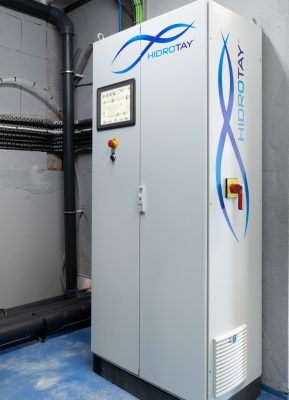Reverse Osmosis Desalination Plant

This Hidrotay reverse osmosis desalination plant, located in the coastal industry, is capable of producing up to 400 m3 of desalinated water per day. The water is collected from the estuary through a mesh filter to retain solids such as algae or shells that can damage the pumps.

Before entering the reverse osmosis membranes, water is pre-treated by a series of filters. The first are two sand filters that remove the coarsest particles, about 50-80 microns in size. It then goes through a couple of microfiltration processes that retain the smallest particles, up to 5 microns. It is important that the feed water of the reverse osmosis process does not present particles larger than this, since the efficiency and useful life of the membranes depend directly on this quality.

The pre-filtered feed water is stored in a buffer tank that feeds the high pressure pump. This pump sends the high pressure water to the reverse osmosis membranes where it is purified. At the outlet of the membranes we obtain two flows: the permeate (purified water) and the rejection (brine water). The rejection, before being returned to the sea, passes through an energy recovery system (ERD) at the outlet of the high pressure pump. Thus, we take advantage of the pressure energy of the reject flow, reducing the consumption of the pump and increasing the process perfomance.


On the other hand, the permeate is sent to a cistern where it is remineralized and chlorine is added to ensure its disinfection along the distribution line. Finally, we obtain quality drinking water that covers all the needs of both the staff and the industrial process of the plant.
In the electrical panel of the plant there is a screen where we can observe the process schematic, with all the main parameters monitored in real time. In addition, thanks to the Internet connection, it is possible to carry out any action at any time by remotely controlling the treatment process.


Do you want more information?

